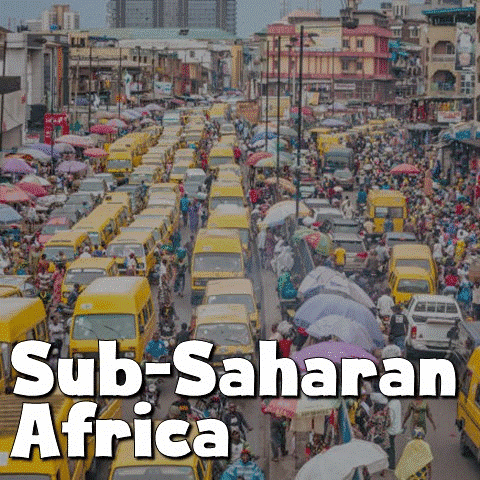Southern African Countries and Geography

Southern Africa includes 11 countries that sit south of the Equator and Congo Rainforest. They feature an array of cultures and a varied geography that includes the Kalahari Desert, Okavango Delta, and landmarks like Table Mountain and Kruger National Park.
Angola's culture is a blend of both original and Portuguese colonial influences. Music and dance play significant roles in Angolan culture, with styles like kizomba and semba. The country boasts tropical rainforests, savannas, and coastal plains. Kalandula Falls on Angola’s Lucala River is one of Africa's largest waterfalls by volume. It is also home to significant mineral resources. Its government is seated in the capital of Luanda. Its economy is reliant on oil.
Botswana has a semi-arid landscape, with the Kalahari Desert covering much of it. Despite the arid conditions, it is home to diverse wildlife and ecosystems, including the Okavango Delta, a unique inland delta where the Okavango River empties into the Kalahari.
The country’s culture is rooted in the traditions of the indigenous Tswana people. Music and storytelling are integral parts of their culture. It has experienced steady economic growth, driven by diamond mining and tourism. The country has also been praised for its political stability and sound economy.
Eswatini is a tiny, mountainous country. Subsistence farming is a common practice among its rural communities. Eswatini is known for its monarchy and traditional ceremonies, such as the Umhlanga (Reed Dance). The Swazi people have a rich oral tradition of storytelling and folklore. The capital city is Mbabane, but the royal and administrative capital is in Lobamba. The country’s economy is reliant on agriculture, particularly sugar cane.
Known as the "Kingdom in the Sky," Lesotho is entirely surrounded by South Africa. It features highland plateaus and mountains. Its geography poses challenges for development and agriculture. Its culture is shaped by its terrain and the traditions of the Basotho people. Traditional clothing, music, and dance are important cultural expressions. Its economy is based on agriculture, textiles, and remittances from Sotho people working abroad. The country faces economic vulnerabilities due to its landlocked status and dependence on external markets.
Madagascar is known for its unique biodiversity, with species found nowhere else on Earth. The island features rainforests, deserts, and coastal mangroves. Madagascar's culture is a fusion of African, Asian, and European influences, shaped by centuries of migration and trade. The Malagasy people have a rich oral tradition, reflected in their music, storytelling, and ceremonies. The economy is mostly agricultural, with rice a staple crop. The country also has significant mineral resources, though economic development has been hindered by political instability.
Malawi's culture is characterized by its diverse ethnic groups, including the Chewa, Yao, and Tumbuka. Music, dance, and oral traditions play central roles in Malawian cultural expression. Malawi is landlocked and dominated by Lake Malawi, which forms part of the Great Rift Valley. Small farms dominate the economy, particularly of tobacco, tea, and corn. The country faces challenges related to widespread poverty.
Mozambique has a diverse geography, with coastal plains, savannas, and tropical forests. The country is prone to natural disasters, including cyclones and flooding, which pose challenges. Mozambique's culture is a blend of African and Portuguese influences. Traditional music and dance, such as marrabenta and makwaya, are important cultural expressions. Mozambique's economy is driven by agriculture, mining, and energy. The discovery of vast natural gas reserves has the potential to transform the country's economy.
Namibia is known for its vast deserts, including the Namib and Kalahari. The country is sparsely populated, with significant wildlife found in national parks and reserves. Its culture is influenced by its diverse ethnic groups, including the Ovambo, Herero, and Himba. Traditional art, music, and dance are all integral parts of its cultural identity. Namibia's economy is dependent on mining, particularly diamonds and uranium. However, Namibia faces challenges related to income inequality and unemployment.
South Africa has a geography that includes savannas, mountains, and coastal plains. The country is rich in mineral resources and includes landmarks like Table Mountain and Kruger National Park. South Africa is a diverse and multicultural society, with influences from African, European, and Asian traditions. The country actually has three capital cities: Pretoria as the administrative capital, Bloemfontein as the judicial capital, and Cape Town as the legislative capital. South Africa has the most diversified economy in the region, with mining, manufacturing, finance, and tourism all contributing to its GDP. However, the country faces challenges related to inequality.
Zambia is diverse, with over 70 ethnic groups contributing to the country's makeup. Traditional ceremonies, music, and dance are important cultural expressions in Zambia. The country's physical geography is marked its vast plateau, rivers, and savannas. The Zambezi River forms its border with Zimbabwe and features s Victoria Falls, one of the world's largest waterfalls. Zambia is endowed with rich mineral resources, including copper, which has been the backbone of its economy. However, Zambia faces challenges related to its lack of infrastructure and high debts.
Zimbabwe features diverse landscapes, including highlands, plateaus, and savannas. The country is also rich in natural resources, including minerals, with the second-largest platinum reserves in the world, and agricultural land. Zimbabwe's culture is influenced by its diverse ethnic groups, including the Shona and Ndebele. Its economy has faced challenges, including hyperinflation and economic downturns. Agriculture, mining, and tourism are key sectors, although the economy remains vulnerable to external shocks and political instability.
